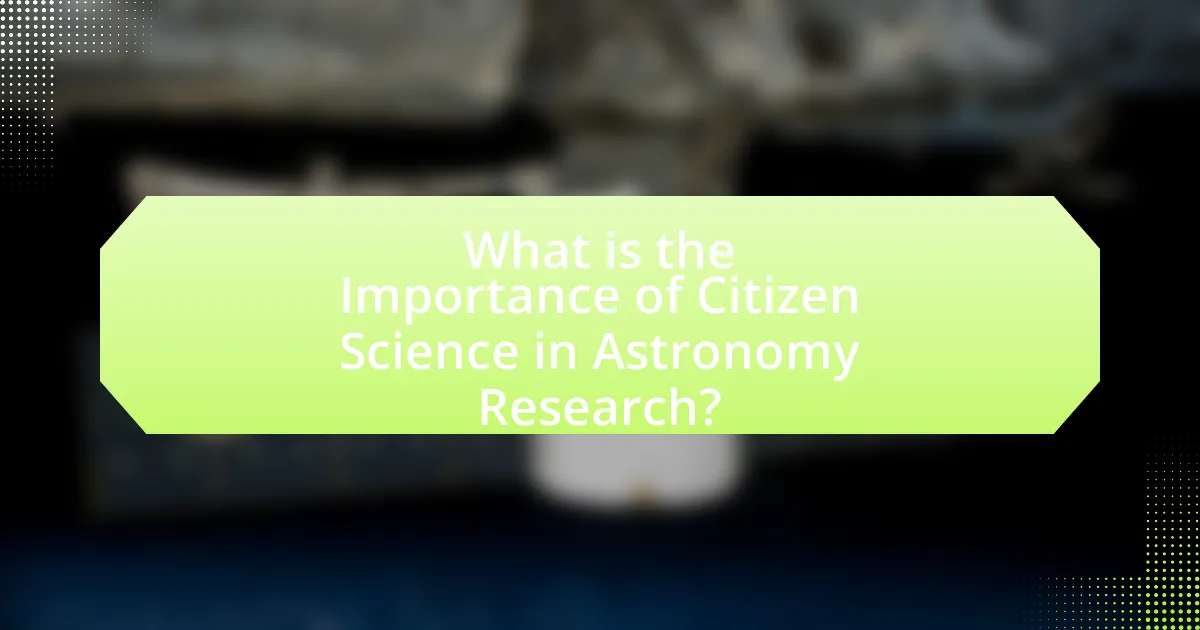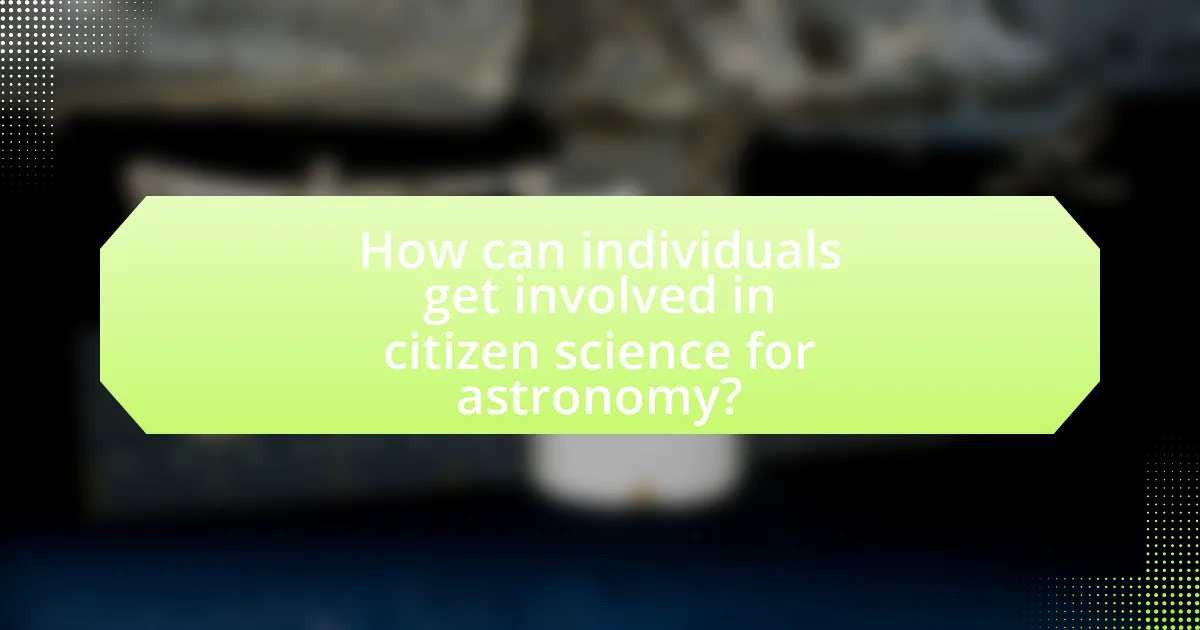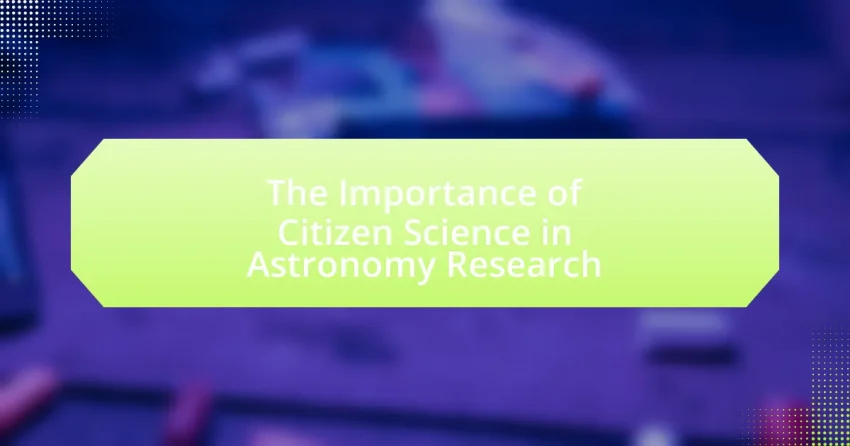Citizen science plays a vital role in astronomy research by enhancing data collection and analysis through the involvement of non-professional astronomers. Projects such as Galaxy Zoo and Planet Hunters have successfully engaged thousands of volunteers, leading to significant discoveries like new galaxy types and exoplanets. This collaborative approach not only accelerates research but also democratizes science, fostering public interest and participation in astronomical studies. The article explores the contributions of citizen scientists, the methodologies employed in successful projects, and the impact of these initiatives on advancing our understanding of the universe. Additionally, it addresses the challenges faced by traditional astronomy and highlights the importance of citizen science for future discoveries.

What is the Importance of Citizen Science in Astronomy Research?
Citizen science is crucial in astronomy research as it significantly enhances data collection and analysis capabilities. By involving non-professional astronomers, large-scale projects like Galaxy Zoo have successfully classified millions of galaxies, contributing to our understanding of cosmic structures. This collaborative approach not only accelerates research but also democratizes science, allowing diverse participation and fostering public interest in astronomy. Studies indicate that citizen contributions can match or even exceed professional efforts in specific tasks, demonstrating the effectiveness of this model in advancing astronomical knowledge.
How does citizen science contribute to astronomical discoveries?
Citizen science significantly contributes to astronomical discoveries by enabling non-professionals to participate in data collection and analysis, which expands the capacity for research. Projects like Galaxy Zoo have engaged thousands of volunteers to classify galaxies, resulting in the identification of new galaxy types and insights into galaxy formation. Additionally, the Planet Hunters project allows citizen scientists to discover exoplanets by analyzing light curves from stars, leading to the identification of numerous new planets. These contributions demonstrate that citizen involvement not only accelerates data processing but also enhances the breadth of astronomical research, as evidenced by the over 1.5 million classifications made by volunteers in Galaxy Zoo alone.
What roles do volunteers play in data collection and analysis?
Volunteers play critical roles in data collection and analysis by contributing time, effort, and diverse skills to scientific projects. They assist in gathering observational data, such as identifying celestial objects or recording astronomical events, which enhances the volume and variety of data available for research. For instance, projects like Galaxy Zoo have utilized thousands of volunteers to classify galaxies, resulting in a dataset that has significantly advanced our understanding of galaxy formation and evolution. Additionally, volunteers often participate in data validation processes, ensuring the accuracy and reliability of the information collected, which is essential for drawing valid scientific conclusions. Their involvement not only accelerates research but also democratizes science, allowing non-experts to contribute meaningfully to significant discoveries in astronomy.
How has citizen science changed the landscape of astronomy research?
Citizen science has significantly transformed astronomy research by enabling non-professionals to contribute to data collection and analysis, thereby expanding the scope and scale of astronomical studies. Projects like Galaxy Zoo have engaged thousands of volunteers in classifying galaxies, resulting in the classification of over 2 million galaxies, which has led to new insights into galaxy formation and evolution. Additionally, citizen scientists have played crucial roles in discovering transient astronomical events, such as supernovae and exoplanets, which would have been challenging for professional astronomers to detect alone. This collaborative approach has not only democratized access to scientific research but also accelerated discoveries, illustrating the profound impact of citizen science on the field of astronomy.
Why is citizen science essential for the future of astronomy?
Citizen science is essential for the future of astronomy because it significantly expands data collection and analysis capabilities beyond traditional professional astronomers. By engaging the public in tasks such as classifying galaxies or monitoring variable stars, citizen scientists contribute to large-scale projects that require vast amounts of data, which would be impractical for professional astronomers to handle alone. For instance, projects like Galaxy Zoo have successfully classified millions of galaxies, demonstrating that citizen contributions can lead to substantial scientific discoveries, such as the identification of new astronomical phenomena. This collaborative approach not only accelerates research but also democratizes science, fostering a broader interest in astronomy and enhancing public understanding of the universe.
What challenges does traditional astronomy face that citizen science addresses?
Traditional astronomy faces challenges such as limited funding, a shortage of observational data, and the need for large-scale data analysis, which citizen science effectively addresses. Citizen science mobilizes a vast number of volunteers to collect and analyze astronomical data, significantly increasing the volume of observations and discoveries. For instance, projects like Galaxy Zoo have engaged thousands of volunteers to classify millions of galaxies, contributing to our understanding of galaxy formation and evolution. This collaborative approach not only supplements professional astronomers’ efforts but also democratizes scientific research, allowing broader participation and accelerating discoveries in the field.
How does citizen science enhance public engagement with astronomy?
Citizen science enhances public engagement with astronomy by actively involving non-professionals in scientific research, thereby fostering a sense of community and shared purpose. Programs like Galaxy Zoo allow volunteers to classify galaxies, which not only contributes valuable data to professional astronomers but also educates participants about astronomical concepts and techniques. Research indicates that participants in citizen science projects report increased interest in astronomy and science literacy, as evidenced by a study published in the journal “Public Understanding of Science,” which found that 80% of participants felt more connected to the scientific community after engaging in such projects. This collaborative approach demystifies science, making it more accessible and encouraging ongoing public interest and participation in astronomical research.

What are the key projects that exemplify citizen science in astronomy?
Key projects that exemplify citizen science in astronomy include Galaxy Zoo, SETI@home, and the Planet Hunters initiative. Galaxy Zoo, launched in 2007, allows volunteers to classify galaxies based on their shapes, contributing to significant discoveries about galaxy formation and evolution. SETI@home, initiated in 1999, enables participants to analyze radio signals from space in the search for extraterrestrial intelligence, utilizing the processing power of personal computers. Planet Hunters, started in 2010, invites citizens to identify exoplanets by analyzing light curves from the Kepler Space Telescope, leading to the discovery of numerous new planets. These projects demonstrate the impactful role of citizen scientists in advancing astronomical research.
How do specific citizen science projects operate?
Specific citizen science projects operate by engaging volunteers in data collection, analysis, and interpretation to contribute to scientific research. For instance, projects like Galaxy Zoo allow participants to classify galaxies based on images from telescopes, enabling researchers to analyze vast amounts of astronomical data more efficiently. This collaborative model leverages the collective effort of non-professionals, enhancing the research capacity of scientists and fostering public interest in astronomy. The success of these projects is evidenced by the publication of numerous scientific papers that have utilized data classified by citizen scientists, demonstrating their significant impact on the field.
What methodologies are used in successful citizen science astronomy projects?
Successful citizen science astronomy projects utilize methodologies such as data collection, public engagement, and collaborative analysis. Data collection often involves volunteers gathering observational data through telescopes or mobile applications, which has been exemplified by projects like Galaxy Zoo, where participants classify galaxies based on images. Public engagement strategies include educational outreach and training sessions to equip volunteers with the necessary skills, as seen in the Citizen Sky project, which trained participants to monitor variable stars. Collaborative analysis is facilitated through online platforms that allow volunteers to contribute to data interpretation and validation, enhancing the overall research quality. These methodologies have proven effective in expanding the scope of astronomical research and fostering community involvement.
What types of data are typically collected by citizen scientists?
Citizen scientists typically collect observational data, including astronomical images, light curves, and spectral data. This data is crucial for various research projects, such as monitoring celestial events, identifying exoplanets, and cataloging astronomical objects. For instance, projects like Galaxy Zoo allow volunteers to classify galaxies based on their shapes, contributing to our understanding of galaxy formation and evolution. Additionally, platforms like Zooniverse enable citizen scientists to analyze data from telescopes, enhancing the volume and diversity of data available for scientific analysis.
What impact have these projects had on scientific knowledge?
Citizen science projects in astronomy have significantly advanced scientific knowledge by enabling large-scale data collection and analysis that would be impossible for professional astronomers alone. These initiatives have led to the discovery of new celestial objects, such as exoplanets and supernovae, and have contributed to the identification of patterns in astronomical data, enhancing our understanding of the universe. For instance, the Galaxy Zoo project, which involved volunteers classifying galaxies, resulted in the discovery of a new type of galaxy and provided insights into galaxy formation and evolution. Such contributions underscore the vital role of citizen science in expanding the frontiers of astronomical research.
How have citizen-led discoveries contributed to major astronomical findings?
Citizen-led discoveries have significantly contributed to major astronomical findings by enabling the identification of celestial phenomena that professional astronomers may overlook. For instance, the discovery of the exoplanet Kepler-186f was made possible through the contributions of citizen scientists analyzing data from NASA’s Kepler mission, which led to the identification of this Earth-sized planet in the habitable zone of its star. Additionally, the Galaxy Zoo project, which enlisted volunteers to classify galaxies, resulted in the discovery of new galaxy types and provided insights into galaxy formation and evolution. These contributions demonstrate that citizen science can enhance data analysis and expand the scope of astronomical research, leading to groundbreaking discoveries.
What are some notable examples of citizen science successes in astronomy?
Notable examples of citizen science successes in astronomy include the discovery of new exoplanets through the Planet Hunters project and the identification of supernovae by volunteers in the Galaxy Zoo initiative. The Planet Hunters project, which utilizes data from NASA’s Kepler mission, has led to the identification of over 1,000 potential exoplanets, showcasing the effectiveness of public participation in data analysis. Similarly, Galaxy Zoo, which invites volunteers to classify galaxies and identify transient astronomical events, has resulted in the discovery of thousands of supernovae, significantly contributing to our understanding of cosmic phenomena. These projects demonstrate how citizen scientists can make substantial contributions to astronomical research, enhancing data interpretation and discovery rates.

How can individuals get involved in citizen science for astronomy?
Individuals can get involved in citizen science for astronomy by participating in projects that allow them to contribute data, observations, or analysis. Numerous platforms, such as Galaxy Zoo and Zooniverse, enable volunteers to classify galaxies, identify exoplanets, or analyze astronomical images. These projects often provide training and resources to help participants understand their contributions, ensuring that even those without a scientific background can engage meaningfully. According to a study published in the journal “Nature Astronomy,” citizen scientists have significantly contributed to the discovery of new celestial objects, demonstrating the impact of public involvement in professional research.
What platforms and resources are available for aspiring citizen scientists?
Aspiring citizen scientists can utilize platforms such as Zooniverse, SciStarter, and Galaxy Zoo to engage in scientific research. Zooniverse offers a variety of projects across multiple disciplines, allowing users to contribute to data analysis and classification tasks. SciStarter serves as a hub for citizen science projects, providing resources and tools to connect individuals with ongoing research initiatives. Galaxy Zoo specifically focuses on astronomy, enabling participants to classify galaxies and contribute to our understanding of the universe. These platforms not only facilitate participation but also enhance public engagement in scientific discovery.
How can individuals choose the right project to participate in?
Individuals can choose the right project to participate in by assessing their interests, skills, and the project’s goals. First, they should identify their personal interests in astronomy, such as observational techniques or data analysis, which aligns with specific projects. Next, evaluating their skills, such as familiarity with software or statistical methods, helps in selecting projects that match their capabilities. Additionally, reviewing the project’s objectives and requirements ensures that participants can contribute effectively and gain valuable experience. Research indicates that engaged participants in citizen science projects report higher satisfaction and learning outcomes when their interests and skills align with the project’s focus, as seen in studies like “The Role of Citizen Science in Astronomy” published in the Journal of Astronomy Education.
What skills or knowledge are beneficial for contributing to astronomy research?
Mathematics and physics are essential skills for contributing to astronomy research. Proficiency in mathematics allows researchers to analyze data, model celestial phenomena, and understand complex equations governing astrophysical processes. Knowledge of physics is crucial for grasping the fundamental principles that govern the universe, such as gravity, thermodynamics, and electromagnetism. Additionally, familiarity with computer programming and data analysis tools enhances the ability to process large datasets, which is increasingly important in modern astronomy. For instance, citizen scientists often utilize software like Python or R to analyze astronomical data, demonstrating the practical application of these skills in real-world research.
What best practices should citizen scientists follow?
Citizen scientists should follow best practices such as ensuring data accuracy, maintaining clear communication, and adhering to ethical guidelines. Ensuring data accuracy involves using standardized methods for observations and recording results meticulously, which is crucial in astronomy where precision is vital for valid research outcomes. Clear communication with project leaders and fellow participants fosters collaboration and enhances the quality of the research. Adhering to ethical guidelines, including respecting privacy and intellectual property, is essential to maintain integrity in scientific contributions. These practices are supported by various citizen science projects that emphasize the importance of reliable data and ethical conduct in their protocols.
How can volunteers ensure the quality and accuracy of their contributions?
Volunteers can ensure the quality and accuracy of their contributions by following established protocols and guidelines specific to the project they are involved in. Adhering to these protocols helps maintain consistency and reliability in data collection and analysis. For instance, projects like Galaxy Zoo provide detailed instructions and training materials that volunteers must review to understand the criteria for classifying galaxies accurately. Research has shown that when volunteers are trained effectively, their contributions can match the quality of professional astronomers, as evidenced by studies published in the journal “Nature,” which highlighted the accuracy of citizen science data in astronomical research.
What common pitfalls should citizen scientists avoid?
Citizen scientists should avoid common pitfalls such as lack of proper training, data misinterpretation, and insufficient communication with professional scientists. Proper training is essential because it ensures that citizen scientists understand the methodologies and tools used in astronomy research, which minimizes errors in data collection. Misinterpretation of data can lead to incorrect conclusions, undermining the validity of the research; for instance, failing to recognize the difference between noise and actual astronomical signals can skew results. Additionally, insufficient communication with professional scientists can result in missed opportunities for collaboration and guidance, which are crucial for the success of citizen science projects. These pitfalls can hinder the overall effectiveness and credibility of citizen science in astronomy.
